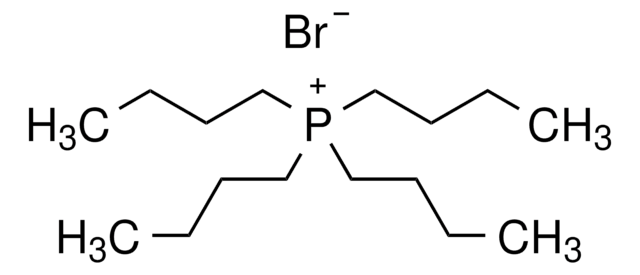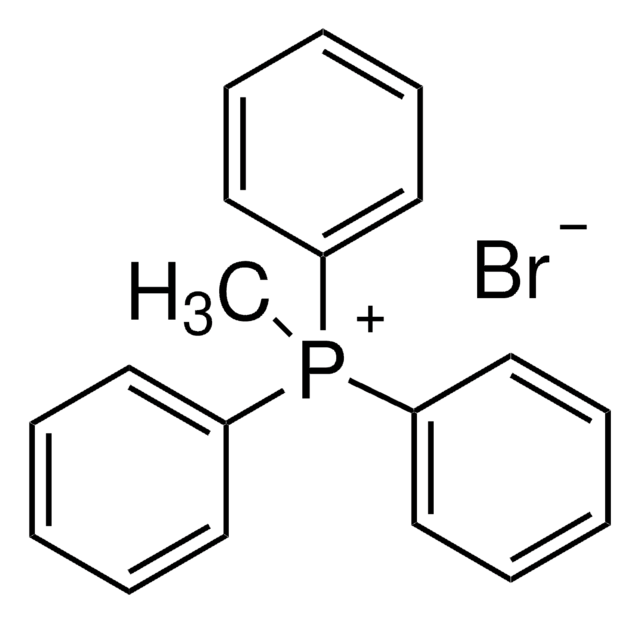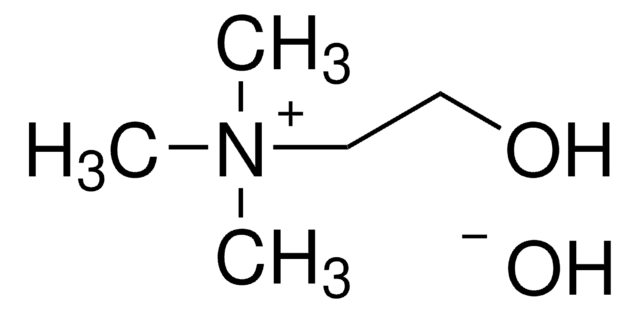438294
Tetrabutylphosphonium hydroxide solution
40 wt. % in H2O
Synonym(s):
TBPH
Sign Into View Organizational & Contract Pricing
All Photos(2)
About This Item
Linear Formula:
(CH3CH2CH2CH2)4P(OH)
CAS Number:
Molecular Weight:
276.44
Beilstein:
4826225
MDL number:
UNSPSC Code:
12352000
PubChem Substance ID:
NACRES:
NA.22
concentration:
40 wt. % in H2O
Recommended Products
form
liquid
Quality Level
concentration
40 wt. % in H2O
refractive index
n20/D 1.412
density
0.989 g/mL at 25 °C
functional group
phosphine
SMILES string
[OH-].CCCC[P+](CCCC)(CCCC)CCCC
InChI
1S/C16H36P.H2O/c1-5-9-13-17(14-10-6-2,15-11-7-3)16-12-8-4;/h5-16H2,1-4H3;1H2/q+1;/p-1
InChI key
DFQPZDGUFQJANM-UHFFFAOYSA-M
Looking for similar products? Visit Product Comparison Guide
Application
Tetrabutylphosphonium hydroxide (TBPH) can be used:
- To convert poorly water-soluble acidic APIs into TBP ionic liquids (IL).
- As a cation source in the synthesis of Good′s buffer ionic liquids (GB-ILs) via an acid−base neutralization reaction with Good′s buffer anions.
- To synthesize tetrabutylphosphonium acetate, which along with Cu2O-nanoparticles forms an excellent catalyst system for protodecarboxylation reactions.
Signal Word
Danger
Hazard Statements
Precautionary Statements
Hazard Classifications
Skin Corr. 1B
Storage Class Code
8A - Combustible corrosive hazardous materials
WGK
WGK 3
Flash Point(F)
Not applicable
Flash Point(C)
Not applicable
Personal Protective Equipment
dust mask type N95 (US), Eyeshields, Gloves
Choose from one of the most recent versions:
Already Own This Product?
Find documentation for the products that you have recently purchased in the Document Library.
Customers Also Viewed
Luca Lo Piccolo et al.
International journal of molecular sciences, 19(4) (2018-04-05)
Over the past decade, evidence has identified a link between protein aggregation, RNA biology, and a subset of degenerative diseases. An important feature of these disorders is the cytoplasmic or nuclear aggregation of RNA-binding proteins (RBPs). Redistribution of RBPs, such
Cecilia Springer et al.
Environmental health perspectives, 120(12), 1711-1719 (2012-09-28)
Bis-(2-ethylhexyl) tetrabromophthalate (TBPH) is widely used as a replacement for polybrominated diphenyl ethers (PBDEs) in commercial flame retardant mixtures such as Firemaster 550. It is also used in a commercial mixture called DP 45. Mono-(2-ethyhexyl) tetrabromophthalate (TBMEHP) is a potentially
Zhiyuan Ma et al.
Environmental science & technology, 52(15), 8764-8773 (2018-07-10)
Long-term exposure to toxic chemicals often has deleterious effects on aquatic organisms. In order to support appropriate environmental management of chemicals, a mathematical model was developed to characterize the effects of chemicals on multigenerational population dynamics in aquatic animals. To
Jer-Cherng Chang et al.
PloS one, 12(7), e0180828-e0180828 (2017-07-08)
Mutations in TDP-43 are associated with proteinaceous inclusions in neurons and are believed to be causative in neurodegenerative diseases such as frontotemporal dementia or amyotrophic lateral sclerosis. Here we describe a Drosophila system where we have engineered the genome to
Evaluating self-buffering ionic liquids for biotechnological applications
Lee SY, et al.
ACS sustainable chemistry & engineering, 3(12), 3420-3428 (2015)
Our team of scientists has experience in all areas of research including Life Science, Material Science, Chemical Synthesis, Chromatography, Analytical and many others.
Contact Technical Service









